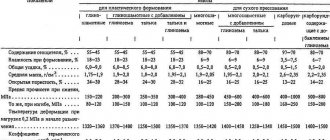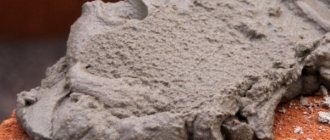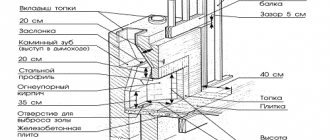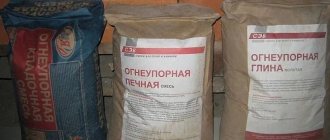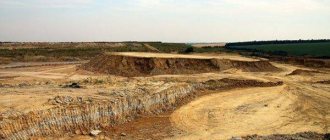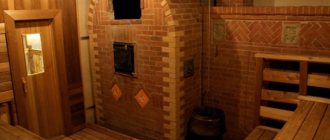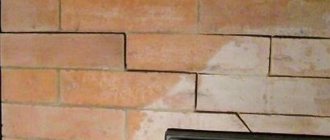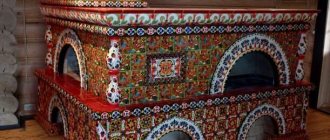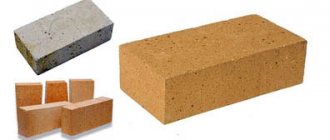Material rating
20 out of 5 Price
20 out of 5
Practicality
20 out of 5
Appearance
20 out of 5
Ease of manufacture
20 out of 5
Environmental friendliness
final grade
5
5 out of 5
Fireclay is made from white kaolin clay, which is thermally treated to increase heat resistance. After processing in hot ovens, fireclay acquires the properties of stone, which is crushed to form fireclay clay. With its help, they equip any heat-resistant structures, make fire-resistant bricks, and beautiful decorative items.
What is fireclay clay, description
Fireclay clay can be found in stores in the form of dry building mass, which is added to masonry and plaster mortars. Fireclay bricks are also sold. Fired kaolin can be white with creamy tones or gray-brown, depending on the firing.
Compound
Fireclay is made from clay, which contains highly dispersed hydroaluminosilicates. This clay is formed into pieces of any shape or pressed briquettes and fired in special ovens heated to a very high temperature.
There are many recipes for making fireclay mass. Some compositions add more calcined powder, others consist of coarse powder, more water in one mass, etc.
Fireclay also varies in duration and firing temperature. As a result, masses of different colors and textures come out of the ovens.
Fire clay consists of many chemical elements:
- Quartz (Si02);
- Aluminum oxide ceramics (Al2O3);
- Calcium oxide (CaO);
- Potassium oxide (K2O);
- Magnesium oxide (MgO);
- Sodium oxide (Na2O),
- Iron oxide (Fe2O3.
Bentonite clay is a material of natural origin, which is distinguished by the fact that it can be used almost everywhere. Its main component is montmorillonite.
Due to the wide variety of types, clay has found application in many industries and areas of life. Find out what you can make from clay here.
Characteristics. Why is this good for laying stoves?
Fireclay clay mortars are ideal for laying fireclay bricks, since the brick and the binding paste have the same coefficient of linear expansion .
When heated, such masonry expands evenly and cracks do not form in the seams.
Fireclay mortar is also suitable for laying ceramic bricks. The characteristics of fireclay clay that make it suitable for kiln construction include:
- High heat resistance (the fired solution does not crack at a temperature of 1300-1850 degrees , depending on the initial characteristics of fireclay).
- High adhesion ( transfers water well to ceramic and fireclay bricks and adheres tightly to them).
- Strength in thin seams, which allows you to make masonry with a thickness of 3-5 mm .
- Strength in wide vertical joints (fireclay clay can be used to fill gaps up to 12 mm wide ).
Important. The consumption of fireclay mortar for stove masonry depends on the thickness of the seams and is 20 kg per 50-100 bricks .
Where and for what is fireclay clay used?
Heat-resistant fireclay clay is used not only for the construction of household stoves. It is used for laying metallurgical and other industrial furnaces . Chamotte is a filler for refractory concrete.
The applied use of fireclay is also widespread. This material is used to make sculptures for the garden, stucco decorations for buildings, decorative ceramics, panels and clay souvenirs, and pottery .
Vessels made from fireclay are durable and elegant. Potters make lightweight jugs, vases, and bowls with thin walls from fireclay clay. The fired dishes produce a melodious, pleasant ringing sound, similar to the ringing of a crystal vessel.
Technical characteristics and properties
When purchasing fireclay clay, you must make sure that its expiration date has not yet expired and that it has been stored under the correct conditions. Since during long-term storage kaolin loses its properties. Humid air is especially dangerous for it.
Fireclay clay is produced in accordance with GOST - 6137-8 and has the following technical characteristics:
- The average grain size is approximately 2 mm.
- Moisture absorption: for high-burnt fireclay from 2 to 10%, for low-burnt fireclay – up to 25%.
- Humidity – no more than 5%.
- Fire resistance – from 1550 to 1850 °C (depending on the composition);
A package of fireclay clay weighing 20 kg is enough to lay 20-30 bricks. For one cubic meter masonry will need 100 kg of calcined kaolin. The finished solution hardens within two days at an air temperature ranging from + 10 to + 25 ° C.
Fireclay clay can be stored in its original packaging for no more than three years, based on the date of manufacture. Full strength is achieved after 28 days.
How to choose quality clay
Fireclay clay called “Kaolin” and ready-made mixtures are sold in construction stores . There are good reviews about both Russian and foreign manufacturers of this heat-resistant material. The best is considered fireclay produced at Western European .
When choosing materials, pay attention to the year of production and its quality . A high-quality mixture and clay do not contain particles exceeding the fraction size indicated on the packaging.
The mixture for preparing the solution should not contain crushed stone or sand larger than 2.5 mm.
The letter “U” on the package indicates that the fireclay is made from recycled, recycled material. The letter “Ш” means that the material has not been recycled, it is better suited for laying the firebox.
Construction materials are stored in specially equipped warehouses. If fireclay is stored in a dry room, in sealed bags, at a temperature from plus 40 to minus 40 degrees , then the shelf life of mixtures and clays is unlimited. Long-term storage ( more than three years ) in conditions of high humidity will lead to deterioration of the properties of the material due to moisture saturation.
Methods of using fireclay clay
Fireclay clay is used to make dry mixtures for preparing plaster and masonry mortars and creating fireproof bricks.
Furnace laying
When building a stove or fireplace, many stove makers try to use heat-resistant bricks made from a clay-fireclay mixture. When choosing it, you should pay attention to the labeling; the letter “Ш” should be indicated on the packaging. Since such a brick is much more expensive, only the firebox is built from it, and the rest of the stove is laid out from ordinary red brick.
Fireclay bricks must also be laid on refractory clay, which has the same expansion coefficients as bricks. For 100 bricks you will need approximately three buckets of mortar.
The video will tell you about the specifics of laying bricks on fireclay clay:
Plaster
Working with fireclay clay is similar to the familiar plastering process. To finish the stoves, you do not need any specific tools; you only need two spatulas - one large and the other medium. They will be quite sufficient for high-quality plastering of stoves.
When applying the solution, do not forget to pick up any spilled drops with a spatula and smooth out any unevenness in a timely manner. The layer should be no thicker than 1 - 2 mm. There is no need to wet the fireclay brick with water. At the end of the work, allow the plaster to dry; the required drying time can be found on the packaging of the mixture. Finishing work can only begin after complete drying.
Other products made from fireclay clay
Designers really like this fire-resistant, especially durable material for its special texture and discreet beauty. Craftsmen make figurines, ceramic dishes, tiles and other things from it. Products made from fireclay clay can decorate the most sophisticated interior.
And all thanks to the fact that fireclay clay, when impurities are added to it, becomes a very plastic material. They also love it for its environmental friendliness, because fireclay clay does not contain toxic impurities. To make artistic ceramics, they take plastic clay of different compositions and add fireclay chips to it. Its share is approximately 40%.
To make a product from fireclay clay, a ceramic artist first develops a sketch. Then they make a mold and fill it with fireclay clay, after which it is sent to dry. The product must dry naturally for a long time so that its geometric shapes are not disturbed.
Examples of using fireclay clay in creativity
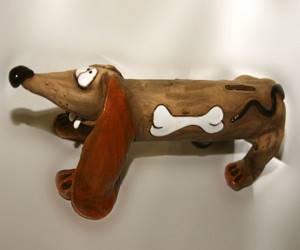
Fireclay clay figurine No. 1
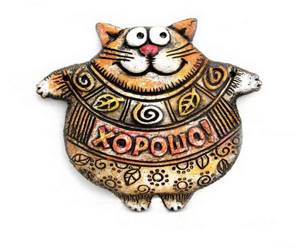
Fireclay clay figurine No. 2

Fireclay clay figurine No. 3

Fireclay clay figurine No. 4

Fireclay clay figurine No. 5
Mineral composition
The raw material for the production of fireclay is clay, consisting of highly dispersed hydroaluminosilicates. In addition to them, the dry mass contains a certain amount of impurities. The extracted raw materials undergo a roasting procedure, after which they are enriched with minerals. There are many recipes that differ in the amount of water, fireclay powder and additives. The duration of heat treatment also varies. It depends on what characteristics the output product should have . The main difference is the colors and types of texture.
Chemical elements in refractory clay:
Instructions for use, consumption of solution, how long it takes to dry
Working with fireclay clay is not easy; many beginners have problems: the masonry turns out to be fragile, cracks appear on the plaster and it crumbles. This happens because when fired, kaolin clay almost completely loses its plastic properties, and when mixing the solution, it needs to regain its plasticity. To do this, add special glue or ordinary quartz sand to the solution.
How to use and breed
Dilute fireclay powder with ordinary water. The proportions are taken depending on the further use of the resulting solution.
How to prepare plaster mortar
- Take a pack of fireclay powder.
- We put it in a special container
- Gradually add water until the powder is completely covered with water.
- After this, leave the diluted clay for at least three days.
- After three days we make the final batch.
- Add quartz sand if the solution is liquid; or water if thick.
- Mix thoroughly by hand or with a special drill.
The finished fireclay solution should have the consistency of thick sour cream, then it will not drain and will stick well to the surface. To speed up the setting time of the solution, you can add cement to it, no more than 2 kg per package of fireclay clay.
You can purchase a composition for instant mixing, which does not need to be infused for three days, but its price is several times higher. PVA construction adhesive is added to both compositions. Sometimes they are reinforced with fiberglass. The finished solution can be applied to the surface using spatulas.
Dilute the mixture in limited quantities, since the hardening time is 48 hours.
How to mix mortar for laying bricks with your own hands
Fireclay clay is diluted with sand and water in a large container; you can take a 10-15 liter tank for this. It is more convenient to mix the solution. Experienced stove makers recommend checking the readiness of the solution by scooping it up with a trowel. If it does not flow and does not stick to the trowel, but slowly slides along it, leaving no traces, the solution is ready for use.
When pressed with a brick, it should completely fill the unevenness of the masonry.
Although fireclay clay is safe, when mixing it, you must take precautions so that the solution does not accidentally get on your face. The work area must have good ventilation.
The video shows how you can check the quality of the prepared mortar before starting masonry:
What is needed for cooking
To make fireclay clay with your own hands you will need:
- dry chamotte clay powder;
- water;
- high capacity;
- trowel or straight stick for stirring.
As a rule, the base for fireclay clay is produced in the form of a powder that must be diluted with water. At the same time, the powder itself is afraid of exposure to moisture, so fireclay clay should be prepared with your own hands in a short period of time so that the powder does not set prematurely. If you have time to thoroughly mix the mixture of powder and water, you will get a homogeneous mass that can be easily applied to the surface. When preparing the solution, experts recommend adding a small amount of glue to the mixture, which will give it additional strength.
Clay-fireclay mortar
Designed for laying fireboxes. It differs from the usual one in its increased degree of heat resistance. Able to withstand temperatures within 1200-1300 degrees Celsius. For the mortar used for the main masonry of the structure, this figure is two times lower, so it is not suitable for the combustion chamber, where the seams formed are exposed to extremely high temperatures. Fireclay sand gives the composition heat resistance. But, given that the base remains clay, this makes it possible to prepare the solution in large volumes. It is enough to add a little water to the prepared mixture, and you can use the pre-prepared mixture again if it has already become more viscous than necessary.
Description of species
Refractory fireclay is a component on the basis of which solutions for various purposes can be prepared. Clay is divided into lump and ground. The lump variety is used for the manufacture of clinker, ceramic and heat-resistant products, and fireclay powder is used to prepare working solutions used for coating or plastering surfaces. In addition, stuffing and molding mixtures are prepared from the powder.
Kaolin clay is also divided by composition, depending on the proportion of fireclay sand. To prepare solutions use:
- binder type clay containing 55% sand;
- smooth type, where sand can be from 20 to 48%;
- depleted type with sand content not exceeding 21%.

Depending on the content of aluminum oxides, the fireclay composition is divided into the following varieties:
- highly basic – no more than 40%;
- main – from 25 to 37%;
- semi-acid – no more than 27%.
In addition, fireclay clay powder is divided into varieties. There are 4 grades in total depending on the composition of impurities and the degree of fire resistance:
- special;
- I grade;
- II grade;
- III grade.

Checking the quality of the solution
The first testing is carried out before preparing the clay for laying the stove. In order for the solution to be of high quality, you need to accurately determine the fat content of the clay. It will depend on what additional components are required.
How fatty clay is for a stove is determined as follows:
- A small amount of clay - approximately 1 kg - is thoroughly cleaned using one of the methods described and soaked for several days.
- The resulting mass is divided into five equal parts. Nothing is added to the first, the second is mixed with 25 percent of sifted sand, the third with 50 percent, the fourth with 75 percent and the fifth with 100 percent.
- Each part is kneaded separately. If necessary, add a little water until a paste-like structure is achieved. You can determine the readiness of the solution with your hands. If it does not stick, the mixture is considered ready.
- The resulting material is tested for plasticity. Each of the five particles is rolled into a small ball and flattened into a flat cake. All resulting samples are marked with labels indicating the proportions of sand and sent to dry. It will take 2-3 days for the fragments to dry.
- The resulting samples are tested. The cake should not be cracked or collapse when compressed. If you throw it on the floor, it should remain intact. Based on the results of such testing, the correct proportion of sand and clay components is revealed.
You can test for fat content and plasticity in another way. Roll balls about 3 cm in diameter, place each one between two carefully planed boards. Gently, smoothly press on the top one and check the condition of the ball. If it immediately cracks, the composition lacks fat content. If cracks occur at half compression, the mixture is too oily. With the correct proportion of components, most of the sample will flatten, but will not collapse.
A properly formulated solution will not crack immediately after application.
Additionally, oven clay is tested before use. It is better to redo the solution than to waste time building a stove that will crumble. To check, scoop the composition with your hand and rub it with your fingers. A good binder solution should be slippery and oily. Experienced stove makers determine the readiness of the composition by ear when kneading.
A correctly made mixture “whispers” - makes a kind of rustling sound, and lags behind the shovel. You can also dip the trowel into the mixture, pull it out, and then turn it over. If a thick layer sticks, the composition is too greasy, you need to dilute it with sand. If the mortar layer falls away, there is excess sand, you need to add clean clay.
Advantages and disadvantages
Fireclay clay mortar has many advantages :
- environmentally friendly material>;
- good vapor permeability;
- fire resistance;
- long service life;
- reliability;
- excellent adhesion.
Among the disadvantages, it should be noted that a mixture made from this material has a higher cost compared to similar materials. Clay production also pollutes the environment, as phenolic resin is used, which releases toxins. Also, during the technological process, a large amount of fireclay dust is generated, so work at such enterprises is very harmful .
From 20 kg. clay, you can prepare a solution that will be enough to lay 25 bricks . To lay out 1m3, you will need 100 kg. fired material .
Fireclay sand
Fireclay is called sintered clay completely devoid of moisture. Refractory sand is usually obtained by grinding fireclay bricks, that is, from scrap. Bulk material is considered more resistant to fire than ordinary sand. It is recommended to add it to the solution for laying the combustion chamber. In addition, it interacts well with the heat-resistant brick from which it was obtained, which allows you to create a particularly strong bond. You should not skimp on this component. It is required in small quantities, but provides the longest service life, which is especially important for the combustion chamber.
Putty and additional additives
The material can be used for putty. True, there should be a slightly different composition here. Stock up on the necessary materials - take 1 part of Portland cement, 2 parts of fireclay clay and 7 parts of quarry sand. The mixture is mixed in the same way as for laying bricks. Metal mesh is used to fix fireclay plaster.
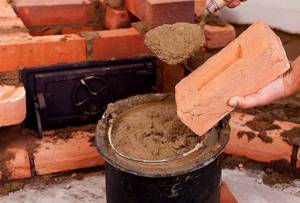
Materials can be added to the clay solution to enhance the necessary properties.
Additives are used to enhance individual properties of the solution. This is PVA glue, liquid glass or table salt. The latter is used 100 g per bucket of solution. The mass fraction of glass should be no more than 3% of the total quantity. Additives are a good option for improving product performance.
Fireclay clay is absolutely safe, but getting it on your face is still undesirable. In addition, optimal air circulation in the room where work is being carried out should be ensured.
Scope of use
If we talk about application, fireclay clay is used as an additive to building materials, which reduces plasticity and shrinkage during drying and firing. For example, the addition of fireclay makes it possible to create sculptures whose weight exceeds two hundred and fifty kilograms.
With the help of this material, the ancient era, the art of Ancient Greece, the motifs of Japanese masters, and elements of primitive art are conveyed.
In European countries, fireclay clay is used in facing works to decorate facades, walls, and fireplaces. The industrial sector uses this material to produce refractory bricks, ceramics, various heat-resistant products, and collectible fireclay tiles.
The rough side retains perfect evenness; the effects of abrasions, unevenness and chipping are created on the front surface. The final cost of the tile depends on the severity of heterogeneity and curvilinearity.
With the help of refractory fireclay clay, the natural beauty of nature is conveyed, which is something that many people lack now. This means that products made from such material are still in demand today, in the age of fashionable European-quality renovations and perfectly smooth surfaces.
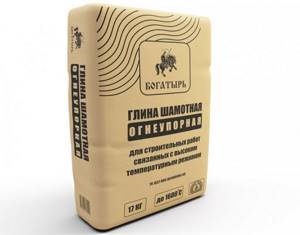
Fireproof fireclay clay
The material has become popular as a decorative finish in world architecture. Its quality has been tested by time, and we can confidently say that fireclay is reliable.
Basic rules for preparing the mixture: composition, proportions
In rural conditions, stove makers do not buy ready-made compositions in the store, but prepare them themselves.
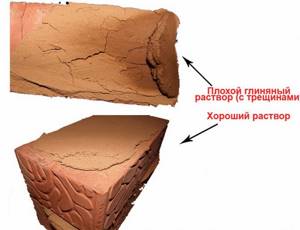
The most popular recipe is a clay-sand mortar with the addition of lime and asbestos:
- 2-3 days before use, the clay should be soaked in water. In this case, all floating debris is immediately removed and refilled with clean water.
- It is better to pass the settled clay through a sieve. Stir until smooth.
Even small lumps should not remain in the clay, otherwise this will be the first reason for the formation of cracks in the coating.
- The clay is combined with dry sifted river sand. You can use wet sand, but then you will need more water to mix the solution. The proportion is 1:2, where one part clay goes to two parts sand.
- When adding lime, it is soaked in water overnight.
- The asbestos will need to be fluffed up.
- For one part of clay there is a tenth of asbestos and lime.
To enhance the plasticity of the solution, add 200 g of kitchen salt to the bucket of plaster. This protects well from cracks and guarantees uniform drying of the treated surface.
Another factor that is worth taking into account is how you will have to heat the stove. If the fuel is coal or peat briquettes, which give off intense heat, then it is recommended to add fireclay powder to the mixture. This will increase the resistance of the coating to high thermal loads.
For a wood-burning stove there is no need for such an additive.
